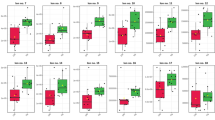Abstract
The crush syndrome, in which rhabdomyolysis and trauma occur as a result of heat stroke and drug intoxication, can lead to myoglobinemia. This condition can be diagnosed by measuring myoglobin (Mb) levels in blood and urine. However, postmortem Mb levels are unreliable indicators, since blood Mb concentration drastically increases within a very short time after death and urine cannot always be obtained at dissection; this makes it difficult to diagnose myoglobinemia in a corpse. To address this issue, in this study, we used a lipidomics approach to identify markers that can be used to detect myoglobinemia in postmortem blood samples. We found that increases in levels of fatty acid oxides such as stearic, oleic, linoleic, and arachidonic acid and decreases in levels of plasmalogens and phosphatidylethanolamine in the blood were associated with high Mb level. These results demonstrate that postmortem samples are amenable to lipidomics analysis and provide a set of markers other than Mb that can be used for postmortem diagnosis of myoglobinemia.




Similar content being viewed by others
References
Nishiumi S, Kobayashi T, Ikeda A, Yoshie T, Kibi M, Izumi Y, Okuno T, Hayashi N, Kawano S, Takenawa T, Azuma T, Yoshida M (2012) A novel serum metabolomics-based diagnostic approach for colorectal cancer. PLoS One 7:e40459
Thomas A, Déglon J, Lenglet S, Mach F, Mangin P, Wolfender JL, Steffens S, Staub C (2010) High-throughput phospholipidic fingerprinting by online desorption of dried spots and quadrupole-linear ion trap mass spectrometry: evaluation of atherosclerosis biomarkers in mouse plasma. Anal Chem 82:6687–6694
Ogawa S, Hattori K, Sasayama D, Yokota Y, Matsumura R, Matsuo J, Ota M, Hori H, Teraishi T, Yoshida S, Noda T, Ohashi Y, Sato H, Higuchi T, Motohashi N, Kunugi H (2015) Reduced cerebrospinal fluid ethanolamine concentration in major depressive disorder. Sci Rep 5:7796
Miyazawa T, Suzuki T, Fujimoto K, Kinoshita M (1996) Age-related change of phosphatidylcholine hydroperoxide and phosphatidylethanolamine hydroperoxide levels in normal human red blood cells. Mech Ageing Dev 86:145–150
Adachi J, Matsushita S, Yoshioka N, Funae R, Fujita T, Higuchi S, Ueno Y (2004) Plasma phosphatidylcholine hydroperoxide as a new marker of oxidative stress in alcoholic patients. J Lipid Res 45:961–971
Hammad LA, Wu G, Saleh MM, Klouckova I, Dobrolecki LE, Hickey RJ, Schnaper L, Novotny MV, Mechref Y (2009) Elevated levels of hydroxylated phosphocholine lipids in the blood serum of breast cancer patients. Rapid Commun Mass Spectrom 23:863–876
Yang L, Li M, Shan Y, Shen S, Bai Y, Liu H (2016) Recent advances in lipidomics for disease research. J Sep Sci 39:38–50
Piischel K, Lockemanna U, Bartelb J (1995) Postmortem investigation of serum myoglobin levels with special reference to electrical fatalities. Forensic Sci Int 72:171–177
Zhu BL, Ishida K, Quan L, Taniguchi M, Oritani S, Kamikodai Y, Fujita MQ, Maeda H (2001) Post-mortem urinary myoglobin levels with reference to the causes of death. Forensic Sci Int 115:183–188
Moore KP, Holt SG, Patel RP, Svistunenko DA, Zackert W, Goodier D, Reeder BJ, Clozel M, Anand R, Cooper CE, Morrow JD, Wilson MT, Darley-Usmar V, Roberts LJ 2nd (1998) A causative role for redox cycling of myoglobin and its inhibition by alkalinization in the pathogenesis and treatment of rhabdomyolysis-induced renal failure. J Biol Chem 273:31731–31737
Reeder BJ, Wilson MT (2005) Hemoglobin and myoglobin associated oxidative stress: from molecular mechanisms to disease states. Current Med Chem 12:2741–2751
Bligh EG, Dyer WJ (1959) A rapid method of total lipid extraction and purification. Can J Biochem Physiol 37:911–917
Niki E, Yoshida Y, Saito Y, Noguchi N (2005) Lipid peroxidation: mechanisms inhibition, and biological effects. Biochem Biophys Res Comm 338:668–676
Zager RA, Foerder CA (1992) Effects of inorganic iron and myoglobin on in vitro proximal tubular lipid peroxidation and cytotoxicity. J Clin Invest 89:989–995
Billings FT 4th, Ball SK, Roberts LJ 2nd, Pretorius M (2011) Postoperative acute kidney injury is associated with hemoglobinemia and an enhanced oxidative stress response. Free Radic Biol Med 50:1480–1487
Holt S, Reeder B, Wilson M, Harvey S, Morrow JD, Roberts LJ 2nd, Moore K (1999) Increased lipid peroxidation in patients with rhabdomyolysis. Lancet 353:1241
Spiteller P, Spiteller G (1997) 9-Hydroxy-10,12-octadecadienoic acid (9-HODE) and 13-hydroxy-9,11-octadecadienoic acid (13-HODE): excellent markers for lipid peroxidation. Chem Phys Lipids 89:131–139
Jira W, Spiteller G, Carson W, Schramm A (1998) Strong increase in hydroxy fatty acids derived from linoleic acid in human low density lipoproteins of atherosclerotic patients. Chem Phys Lipids 91:1–11
Manini P, Briganti S, Fabbri C, Picardo M, Napolitano A, d’Ischia M (2006) Free radical oxidation of 15-(S)-hydroxyeicosatetraenoic acid with the Fenton reagent: characterization of an epoxy-alcohol and cytotoxic 4-hydroxy-2E-nonenal from the heptatrienyl radical pathway. Chem Phys Lipids 142:14–22
Zommara M, Tachibana N, Mitsui K, Nakatani N, Sakono M, Ikeda I, Imaizumi K (1995) Inhibitory effect of ethanolamine plasmalogen on iron- and copper-dependent lipid peroxidation. Free Radic Biol Med 18:599–602
Sindelar PJ, Guan Z, Dallner G, Ernster L (1999) The protective role of plasmalogens in iron-induced lipid peroxidation. Free Rad Biol Med 26:318–324
Stadelmann-Ingrand S, Favreliere S, Fauconneau B, Mauco G, Tallineau C (2001) Plasmalogen degradation by oxidative stress: production and disappearance of specific fatty aldehydes and fatty α-hydroxyaldehydes. Free Rad Biol Med 31:1263–1271
Hara S, Kanda A (2006) Anti-oxidative activity of tocopherol for functional polyunsaturated lipid under various oxidation conditions. J Fac Sci Tech Seikei Univ 43:95–101
Author information
Authors and Affiliations
Corresponding author
Rights and permissions
About this article
Cite this article
Abe, H., Yajima, D., Hoshioka, Y. et al. Myoglobinemia markers with potential applications in forensic sample analysis: lipid markers in myoglobinemia for postmortem blood. Int J Legal Med 131, 1739–1746 (2017). https://doi.org/10.1007/s00414-017-1657-8
Received:
Accepted:
Published:
Issue Date:
DOI: https://doi.org/10.1007/s00414-017-1657-8




